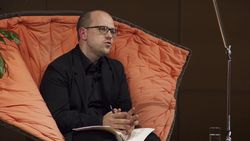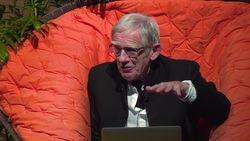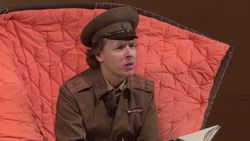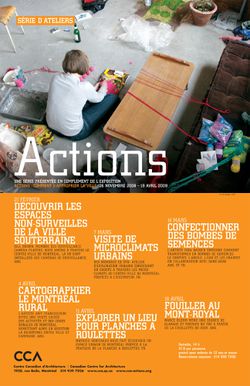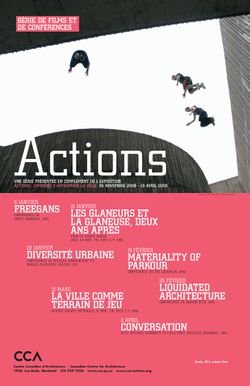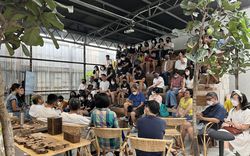Individuals act as their own historians, suppressing some stories and emphasizing others. But at the scale of nations and cultures, and especially in this age of ubiquitous digital memory, it has become more difficult to forget. Building on questions about history and its uses, raised by exhibitions like Educating Architects: Four Courses by Kenneth Frampton and Besides,(...)
7 December 2017
Come and Forget the Internet, with Evgeny Morozov
Actions:
Description:
Individuals act as their own historians, suppressing some stories and emphasizing others. But at the scale of nations and cultures, and especially in this age of ubiquitous digital memory, it has become more difficult to forget. Building on questions about history and its uses, raised by exhibitions like Educating Architects: Four Courses by Kenneth Frampton and Besides,(...)
Individuals act as their own historians, suppressing some stories and emphasizing others. But at the scale of nations and cultures, and especially in this age of ubiquitous digital memory, it has become more difficult to forget. Building on questions about history and its uses, raised by exhibitions like Educating Architects: Four Courses by Kenneth Frampton and Besides,(...)
Craig Hodgetts
29 March 2018
Come and Forget the Grid, with Craig Hodgetts
Actions:
Description:
Individuals act as their own historians, suppressing some stories and emphasizing others. But at the scale of nations and cultures, and especially in this age of ubiquitous digital memory, it has become more difficult to forget. Building on questions about history and its uses, raised by exhibitions like Educating Architects: Four Courses by Kenneth Frampton and Besides,(...)
Craig Hodgetts
Individuals act as their own historians, suppressing some stories and emphasizing others. But at the scale of nations and cultures, and especially in this age of ubiquitous digital memory, it has become more difficult to forget. Building on questions about history and its uses, raised by exhibitions like Educating Architects: Four Courses by Kenneth Frampton and Besides,(...)
Johannes Grenzfurthner
12 April 2018
Come and Forget the Counterculture, with Johannes Grenzfurthner
Actions:
Description:
Individuals act as their own historians, suppressing some stories and emphasizing others. But at the scale of nations and cultures, and especially in this age of ubiquitous digital memory, it has become more difficult to forget. Building on questions about history and its uses, raised by exhibitions like Educating Architects: Four Courses by Kenneth Frampton and Besides,(...)
Johannes Grenzfurthner
textual records
DR2012:0012:063:007
Description:
Assorted newspaper clippings in English (predominant) and French, notes, and sketches. Includes the following original divisions: - Walking Harlem; Manhattan series; - Québec dictionnaire; Geometric ruins; Series #8; - Lenin’s tomb continued; - Parable series, 1990-1992; - Running/walking stiffs; - Monuments; - People/refugees carrying away cities; - Group photos as cities; - Displaced cities; Situationists updated; - [Untitled]; - Series: group photo in collective form; - Series: Walking stiffs; Factory stiffs; Laid off; Particular pieces of factories; - Dictionnaire series: Rust belt; Abandoned cities; - Dictionnaire, misc. Original folder inscribed in graphite: ARTWORK SERIES RUNNING STIFFS MISC. MONUMENTS.
1968-1984, 1991-2000
Assorted newspaper clippings, notes, and sketches, Walking stiffs
Actions:
DR2012:0012:063:007
Description:
Assorted newspaper clippings in English (predominant) and French, notes, and sketches. Includes the following original divisions: - Walking Harlem; Manhattan series; - Québec dictionnaire; Geometric ruins; Series #8; - Lenin’s tomb continued; - Parable series, 1990-1992; - Running/walking stiffs; - Monuments; - People/refugees carrying away cities; - Group photos as cities; - Displaced cities; Situationists updated; - [Untitled]; - Series: group photo in collective form; - Series: Walking stiffs; Factory stiffs; Laid off; Particular pieces of factories; - Dictionnaire series: Rust belt; Abandoned cities; - Dictionnaire, misc. Original folder inscribed in graphite: ARTWORK SERIES RUNNING STIFFS MISC. MONUMENTS.
textual records
1968-1984, 1991-2000
Members of the Montréal collective SYN-atelier d’exploration urbaine present a workshop investigating urban microclimates in downtown Montréal. Caused by particular conditions in urban construction, microclimates are environments that have surprising temperature variations — a building courtyard that is several degrees warmer than the street or a windy alley many degrees(...)
7 March 2009
Exploring Urban Microclimates
Actions:
Description:
Members of the Montréal collective SYN-atelier d’exploration urbaine present a workshop investigating urban microclimates in downtown Montréal. Caused by particular conditions in urban construction, microclimates are environments that have surprising temperature variations — a building courtyard that is several degrees warmer than the street or a windy alley many degrees(...)
Learning from... Athens
Konstantinos Pantazis, co-founder of Point Supreme, discusses the work of the Athens-based practice. The talk focuses on ways to challenge the current crisis condition, proactive proposals for improving the city, addressing the collective unconscious, and building without money. It presents the processes behind examples from the two opposite ends of Point Supreme’s(...)
Paul-Desmarais Theatre
7 April 2016, 6pm
Learning from... Athens
Actions:
Description:
Konstantinos Pantazis, co-founder of Point Supreme, discusses the work of the Athens-based practice. The talk focuses on ways to challenge the current crisis condition, proactive proposals for improving the city, addressing the collective unconscious, and building without money. It presents the processes behind examples from the two opposite ends of Point Supreme’s(...)
Paul-Desmarais Theatre
Series
Projets et réalisations
AP066.S2
Description:
Issue de la pratique professionnelle de Jacques Rousseau, cette série regroupe les documents illustrant quatre-vingt-trois projets et réalisations conçus, soit de façon autonome ou en collaboration, entre 1973 et 1997. Ces projets se distinguent autant par leur degré d'achèvement (de l'esquisse préliminaire au dessin de construction), par leur échelle (du mobilier au projet urbain), que par leur programme (commercial, domestique, social). Dans l'ensemble, tous les thèmes qui sont explorés, tels l'architecture du bar, le décor de la boutique, l'habitation individuelle et collective, le lieu de travail, et l'image publique des institutions, s'ancrent dans une pensée spéculative sur la ville comme processus de reconstruction et de refondation. Parmi les quatre-vingt-trois projets, vingt datent d'avant 1980, date à laquelle Jacques Rousseau est devenu membre de l'Ordre des architectes du Québec. Ces projets ont donc été réalisés soit pour le compte d'agences pour lesquelles Jacques Rousseau travaillait ou effectuait son stage professionnel, soit à titre officieux en offrant vraisemblablement ses services à ses connaissances. Dans ce dernier cas, il s'agit alors de projets de plus petite envergure pour des rénovations ou agrandissements de résidences. Par ailleurs, un certain nombre de nouveaux projets n'ont pas abouti et sont constitués seulement de dossiers préliminaires qui nous renseignent toutefois sur les démarches entreprises par l'architecte, parfois de sa propre initiative, pour amorcer des projets. La variété de ces derniers montre les multiples intérêts de Jacques Rousseau. Toutefois, trois d'entre eux émergent de sa pratique : l'architecture de bar et de restaurant, le logement collectif coopératif et la morphologie urbaine pour lesquels il consacre de nombreux projets et études. On trouvera aussi d'ailleurs dans la série 9 - Enseignement des documents relatifs à ses travaux sur la morphologie urbaine.
1973-1997
Projets et réalisations
Actions:
AP066.S2
Description:
Issue de la pratique professionnelle de Jacques Rousseau, cette série regroupe les documents illustrant quatre-vingt-trois projets et réalisations conçus, soit de façon autonome ou en collaboration, entre 1973 et 1997. Ces projets se distinguent autant par leur degré d'achèvement (de l'esquisse préliminaire au dessin de construction), par leur échelle (du mobilier au projet urbain), que par leur programme (commercial, domestique, social). Dans l'ensemble, tous les thèmes qui sont explorés, tels l'architecture du bar, le décor de la boutique, l'habitation individuelle et collective, le lieu de travail, et l'image publique des institutions, s'ancrent dans une pensée spéculative sur la ville comme processus de reconstruction et de refondation. Parmi les quatre-vingt-trois projets, vingt datent d'avant 1980, date à laquelle Jacques Rousseau est devenu membre de l'Ordre des architectes du Québec. Ces projets ont donc été réalisés soit pour le compte d'agences pour lesquelles Jacques Rousseau travaillait ou effectuait son stage professionnel, soit à titre officieux en offrant vraisemblablement ses services à ses connaissances. Dans ce dernier cas, il s'agit alors de projets de plus petite envergure pour des rénovations ou agrandissements de résidences. Par ailleurs, un certain nombre de nouveaux projets n'ont pas abouti et sont constitués seulement de dossiers préliminaires qui nous renseignent toutefois sur les démarches entreprises par l'architecte, parfois de sa propre initiative, pour amorcer des projets. La variété de ces derniers montre les multiples intérêts de Jacques Rousseau. Toutefois, trois d'entre eux émergent de sa pratique : l'architecture de bar et de restaurant, le logement collectif coopératif et la morphologie urbaine pour lesquels il consacre de nombreux projets et études. On trouvera aussi d'ailleurs dans la série 9 - Enseignement des documents relatifs à ses travaux sur la morphologie urbaine.
Series
1973-1997
Urban Diversity
Two members of the French collective Coloco, architect Nicolas Bonnenfant and landscape architect Miguel Georgieff, present their project “Habiter les Squelettes,” which aims to recover and renovate unfinished, abandoned structures or “urban skeletons”, giving rise to a new dimension in self-building: lifespan management, including that of everyday objects such as(...)
Paul Desmarais Theatre
22 January 2009
Urban Diversity
Actions:
Description:
Two members of the French collective Coloco, architect Nicolas Bonnenfant and landscape architect Miguel Georgieff, present their project “Habiter les Squelettes,” which aims to recover and renovate unfinished, abandoned structures or “urban skeletons”, giving rise to a new dimension in self-building: lifespan management, including that of everyday objects such as(...)
Paul Desmarais Theatre
Making Mamak, Emerging curator 2022-2023, Malaysian art collectives, south east asia, commoning
25 August 2024
Field Notes: From an Island to a Peninsula, and Back to Another Island
Clarissa Lim Kye Lee reflects on the findings from Making Mamak
Actions:
articles
25 August 2024
Nuit Blanche 2025: 38%
It is time for a systemic change in the way we design and value the built environment. The way we build is not ecologically sustainable. The building industry is responsible for 38% of the worlds annual production of greenhouse gases. During the Nuit Blanche at the CCA, we invite you to come and discuss, reflect and be inspired by the actions of the German architecture(...)
Nuit Blanche 2025
1 March 2025 to 2 March 2025, 7pm to 1am
Nuit Blanche 2025: 38%
Actions:
Description:
It is time for a systemic change in the way we design and value the built environment. The way we build is not ecologically sustainable. The building industry is responsible for 38% of the worlds annual production of greenhouse gases. During the Nuit Blanche at the CCA, we invite you to come and discuss, reflect and be inspired by the actions of the German architecture(...)
Nuit Blanche 2025
